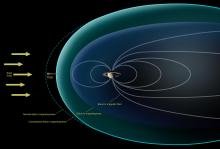Listen to today's episode of StarDate on the web the same day it airs in high-quality streaming audio without any extra ads or announcements. Choose a $8 one-month pass, or listen every day for a year for just $30.
You are here
Saturn at Opposition II
Lightning can make an AM radio station crackle. It can also produce radio static on other planets. In fact, the Cassini spacecraft recorded this “crackling” from storms on Saturn, the second largest planet in the solar system.
Lightning on Saturn can be up to 10,000 times stronger than the typical flash here on Earth. But it’s also much less common: thousands of flashes per year, compared to millions on Earth.
Lightning on Saturn forms in the same way as lightning on Earth: in big thunderstorms. Warm water vapor rises high into the atmosphere, creating static electricity. When that static discharges, it produces lightning.
Most of the lightning on Saturn has been concentrated in one region of the southern hemisphere, and a single monster storm in the northern hemisphere. The southern region is known as “storm alley.” One storm in that region lasted for nine months, although it didn’t produce lightning all the time.
The northern storm eventually wrapped around the entire planet. It produced the highest rate of lightning flashes yet recorded — about 10 per second: the most brilliant display yet seen on the giant planet.
We can’t see the lightning from here on Earth, but we can see Saturn. It’s in the southeast at nightfall, and looks like a bright golden star. It arcs across the southern sky during the night, and sets around sunrise. More about Saturn tomorrow.





